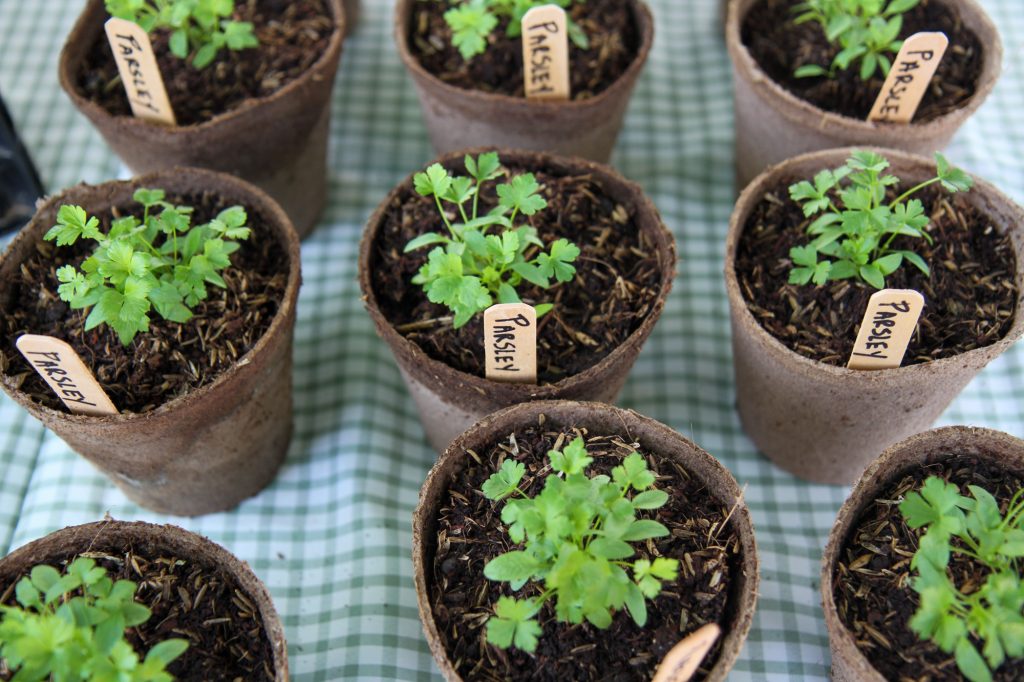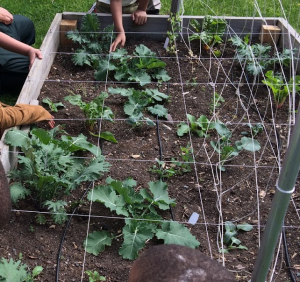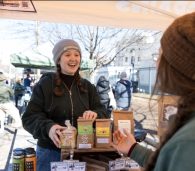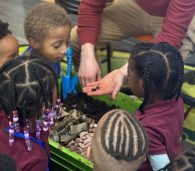Let It Grow! Simple Tips for Starting a Home Garden From The FoodPrints Team

FoodPrints, FRESHFARM’s experiential food and nutrition education program embedded in 20 DC Public Schools across the city, is led by skilled teachers and incredible gardeners. When pondering how to get started with a home garden, we knew who to turn to: FoodPrints Garden Director and Instructional Coach Rebecca Helgerson and Ehren Vance, FoodPrints Garden Manager, who together oversee all beautiful and productive FoodPrints gardens. The tips below are tailored to Washington, DC, and the surrounding areas. If planning a garden outside the Mid-Atlantic region, look up your USDA Hardiness Zone before starting.
Simple Gardening Recommendations: Five Easy Things to Grow at Home
- Perennial herbs.
 Perennials are plants that grow for many years without needing to be replanted. Some perennials keep their leaves through winter, while others die back to the ground and regrow come spring. These are easy because once established, they basically take care of themselves and require minimal water. Rosemary, oregano, thyme, and mint are all good options. Don’t try to start these from seed, though. These will work better if you buy seedlings (which you can find at farmers markets in the spring) or dig up a piece of a friend’s plant! Learn how to store and use fresh herbs.
Perennials are plants that grow for many years without needing to be replanted. Some perennials keep their leaves through winter, while others die back to the ground and regrow come spring. These are easy because once established, they basically take care of themselves and require minimal water. Rosemary, oregano, thyme, and mint are all good options. Don’t try to start these from seed, though. These will work better if you buy seedlings (which you can find at farmers markets in the spring) or dig up a piece of a friend’s plant! Learn how to store and use fresh herbs. - Radishes. Radishes are one of the fastest-growing vegetables around. You can harvest these about 30 days after putting the seed into soil. They also don’t take up much space; you can plant 16 radishes in one square foot. Buy a packet of mixed-color radishes, such as Easter Egg, and enjoy a rainbow of radishes one month later! Plant them in full or part sun in spring or fall, as most radishes like cool weather. Harvest radishes when the colorful round root sticks up out of the ground and looks like it is about one inch in diameter. Make one of FoodPrints’ favorite recipes, Radishes with Bread and Butter.
- Swiss chard. Swiss chard is one of the easiest greens to grow. It has few pests compared to most other greens. Chard’s primary pest is the leaf miner bug that chews out the inside of the plant, leaving beautiful wavy patterns behind that can eventually damage the plant. If you see this, the simplest thing to do is harvest the damaged leaves before it spreads to the rest of the plant or other nearby plants. Swiss chard is biennial, which means it grows for two years and can grow in full or part sun. It also can grow in all four seasons in the Mid-Atlantic region, only dying back in a sustained freeze such as the one we had in late December. Plus, it is beautiful! Try starting it from seed directly in the ground where you will grow it, or buy seedlings to get a jump start on your harvest. Learn more about growing with the seasons.
- Strawberries. Strawberries are so flavorful when fresh and are not hard to grow, even in pots. They are perennial and take a couple of years to get established and produce a lot of fruit. Plant seedlings at least 8 inches apart, and be prepared for them to take over wherever you plant them in a few years. They spread through runners, stems that grow along the ground with a new plant at the end that will send down roots wherever it lands. Strawberries like full sun and usually bear fruit in May and June, but there are a few varieties that fruit all summer. Make FoodPrints strawberry-balsamic vinaigrette.
- Cucumbers. Cucumbers are so satisfying to grow and will do well with a little more attention than the above options—plant cucumbers by seed in late spring through mid-summer, where they will get full sun. Cucumbers need to be watered more regularly than anything else on this list. Cucumber plants are vines and will do best if trellised. Otherwise, they will sprawl all over the place, and the fruits are more likely to rot if they are on the ground. You can let them climb on an existing fence, build a simple trellis out of strong sticks and twine, or purchase one made for this purpose. It is essential to pick them as soon as they are ready; the more you pick, the more the plant will produce, and they are also the best tasting when small- or medium-sized. Make cucumber raita.
Five Recommendations for Gardening in the Ground, Raised Beds, or Containers
- Healthy soil: A healthy, productive garden starts with healthy soil, which is more complicated than it seems. Plants make their food from energy from the sun through photosynthesis, but they get their nutrients from the soil. Since soil is where the plant’s roots are growing, they need enough room to spread out and bring water and nutrients to the plant. The ideal soil mix changes depending on where and how you are gardening. If you are growing in raised beds or pots, consider making or buying a mixture made for that purpose that includes compost, topsoil, peat moss or coconut coir, or even rice hulls. This mixture helps keep a good balance of air and water in the soil and is a homemade potting soil mix. You can purchase ready-made potting soil if growing in just a few small pots. You want to avoid too much topsoil in raised beds because it can get compacted.Each year or two, you should add compost by top-dressing your soil, which means putting it right on top instead of digging it in. This is because when you dig soil, it can disturb the important micro- and macro-organisms living in it. If you are growing directly in the ground, add some compost so that the soil is rich in organic matter and is not too compacted.One simple option for starting a new garden is to put cardboard or multiple layers of newspaper down on top of the existing grass, then add compost on top of that. You can plant right into the compost, and the paper will eventually decompose, and most of the grass will be smothered. This technique saves you the time and energy of digging and does not harm the microorganisms living in the soil. Learn more about soil health here.
- Water: The right amount of water is vital to successful gardening. Always water at the soil level around a plant, not the stem or leaves or any other upper part of the plant. Plants take water in from their roots, which are in the soil. Watering the stem, leaves, and other parts of the plant wastes your time and water because a lot of it will evaporate before the plant’s roots can get it, and too much water on the upper parts of the plant can lead to rot or diseases. Over the summer, on hot days, it is more efficient to water in the morning before the sun (and the temperature!) rises very high, allowing the plant’s roots to access the water before it evaporates. Lastly, when you first put seeds into soil, ensure they don’t dry out before growing their first few real leaves. Soil for seed starting should be moist but not soaking wet. Learn more about water and how to conserve it.
- Sun: The right amount of sun is necessary for plants to thrive. A simple way of looking at it is that plants need either full shade, part sun, or full sun. Full sun is considered more than 6 hours of direct sunlight daily and usually means a south or west-facing garden area. Part sun means around 4-6 hours of direct sun each day, and full shade means little to no direct sun each day. Most vegetable garden plants need full sun, and this is especially important for things that produce fruit, such as tomatoes, peppers, eggplant, and okra. A few that will do well in part sun include lettuce, kale, peas, beets, cilantro, and parsley. Watch our instructional video, The Energy We Eat.
- Space:
 There are three ways to think about space for growing plants: Space underground, space along and near the ground, and space moving upwards away from the ground. Use space above the ground to maximize a small area and grow plants along a trellis or fence. Plants that climb, such as cucumbers, pole beans, winter squash, and peas, don’t need much space at the soil level but will climb all over whatever is nearby. Root crops such as carrots and beets need space for their edible roots to grow big enough to harvest. Then there are the bushy plants such as eggplant and peppers and bush beans which require about 18” of space all around them so that they can spread out. When things are planted too close together, it can lead to rot and diseases. Dive deeper into garden planning.
There are three ways to think about space for growing plants: Space underground, space along and near the ground, and space moving upwards away from the ground. Use space above the ground to maximize a small area and grow plants along a trellis or fence. Plants that climb, such as cucumbers, pole beans, winter squash, and peas, don’t need much space at the soil level but will climb all over whatever is nearby. Root crops such as carrots and beets need space for their edible roots to grow big enough to harvest. Then there are the bushy plants such as eggplant and peppers and bush beans which require about 18” of space all around them so that they can spread out. When things are planted too close together, it can lead to rot and diseases. Dive deeper into garden planning. - Pollinators. Most plants in a vegetable garden that bear fruit will need pollinators to do so. Bees and butterflies will be more attracted to your garden if you grow some flowers specifically for them, and then they will help you out by visiting your squash and tomato flowers also! Try growing native flowers such as echinacea, black-eyed Susan, or anise hyssop. Or, add some edible flowers to your garden, such as nasturtium and borage. Learn more about pollinators.
Looking for fun and educational gardening projects to do at home with kids? Check out FoodPrints Anywhere!


